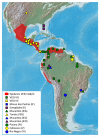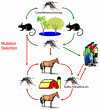Alphaviruses: population genetics and determinants of emergence
- PMID: 22522323
- PMCID: PMC3737490
- DOI: 10.1016/j.antiviral.2012.04.002
Alphaviruses: population genetics and determinants of emergence
Abstract
Alphaviruses are responsible for several medically important emerging diseases and are also significant veterinary pathogens. Due to the aerosol infectivity of some alphaviruses and their ability to cause severe, sometimes fatal neurologic diseases, they are also of biodefense importance. This review discusses the ecology, epidemiology and molecular virology of the alphaviruses, then focuses on three of the most important members of the genus: Venezuelan and eastern equine encephalitis and chikungunya viruses, with emphasis on their genetics and emergence mechanisms, and how current knowledge as well as gaps influence our ability to detect and determine the source of both natural outbreaks and potential use for bioterrorism. This article is one of a series in Antiviral Research on the genetic diversity of emerging viruses.
Copyright © 2012 Elsevier B.V. All rights reserved.
Figures











References
-
- Aguilar PV, Greene IP, Coffey LL, Medina G, Moncayo AC, Anishchenko M, Ludwig GV, Turell MJ, O'Guinn ML, Lee J, Tesh RB, Watts DM, Russell KL, Hice C, Yanoviak S, Morrison AC, Klein TA, Dohm DJ, Guzman H, Travassos da Rosa AP, Guevara C, Kochel T, Olson J, Cabezas C, Weaver SC. Endemic Venezuelan equine encephalitis in northern Peru. Emerging Infectious Diseases. 2004;10:880–888. - PMC - PubMed
-
- Aguilar PV, Robich RM, Turell MJ, O'Guinn ML, Klein TA, Huaman A, Guevara C, Rios Z, Tesh RB, Watts DM, Olson J, Weaver SC. Endemic eastern equine encephalitis in the Amazon region of Peru. American Journal of Tropical Medicine and Hygiene. 2007a;76:293–298. - PubMed
Publication types
MeSH terms
Grants and funding
LinkOut - more resources
Full Text Sources
Other Literature Sources

